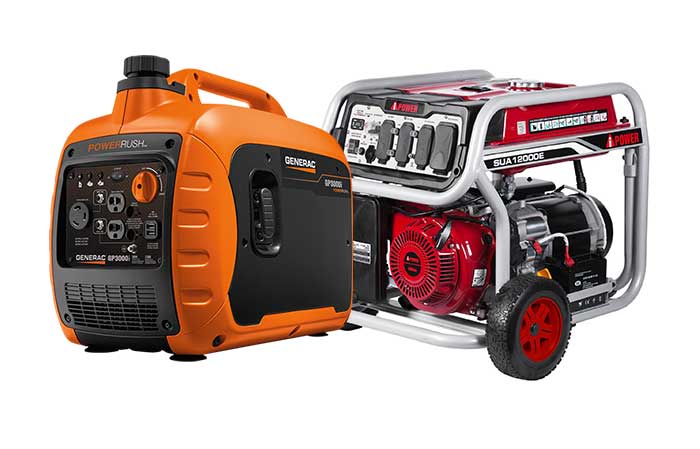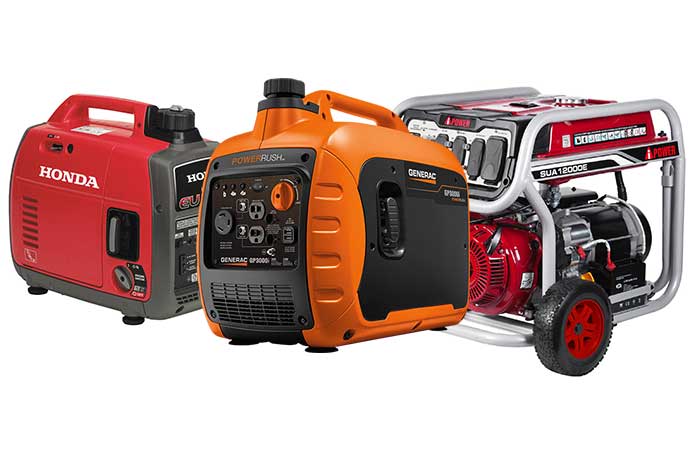While generators are small in size, they provide lots of power which can be a risk to the users if not used properly. If you’re buying a generator for the first time or have little knowledge about how the safety measures for the generator work, you’re better off enlisting the services of an expert to handle that.
Although the focus is on portable generators, the same safety measures apply to standby generators since their modes of operation is generally the same. Some safety measures also apply to any electrical appliance as they have the same individual guidelines.
In this article, we focus on what measures you can use to ensure both the generator and the users are safe during its operation. If you’re not aware of some of the terms used here or it’s your first interaction with a generator, you need to enlist the services of an expert to do that for you.

Safety tips and guidelines
Some of the safety tips to put in practice with your generator include the following:
- Always ensure the generator has enough ventilation when you’re using it. This works in two ways in that it provides air for cooling the engine and, most importantly, prevents the buildup of the poisonous carbon monoxide gas. You’re thus better off operating the generator from the outdoors or in a well-ventilated shed.
- Never install a permanent generator without a transfer switch. This switch prevents the back feed of energy from your generator to the utility equipment which may lead to electric shock if not handled properly.
- Avoid plugging a generator into a wall socket as it may lead to back feed which has the effects stated above. Instead, use heavy duty extension cords in connecting electric appliances to the outlets on a generator.
- Never start the generator with the power outlet plugged in. This overloads the generator and has the risk of short-circuiting your appliances. Instead, start the generator then, when the roar has stabilized, plug in your electric appliances one at a time.
- Only operate the generator with the right type of fuel for it. Check whether your generator uses diesel, gasoline, propane or natural gas. Using the wrong fuel will only lead to damage to the engine of your generator. This usually leads to a costly replacement.
- Never operate your generator in wet conditions as you run the risk of electric shock. Instead, always cover the generator in a canopy that’s well-ventilated. If your hands are wet, don’t touch the generator or operate it as you also risk electric shock. Besides that, wet conditions are likely to damage the generator especially the electric circuitry.
- Avoid fueling the generator when it’s still hot especially with the light fuels such as propane and gasoline. This is because they’re highly flammable and likely to cause a fire. For gasoline especially, the only way to refuel it is to turn off the engine, wait for it to cool down then refuel it. For propane and diesel, you can have larger feeder tanks with a pipe to the generator’s tank for an extended runtime. Generators that run on natural gas are much more convenient since they only rely on the natural gas supply in the home or a tank of the same gas.
- Always keep pets and children away from the generator as it runs. This is because it becomes quite hot and can easily scald them. Other than that, it’s also a fire hazard with the risk of fire increased in the company of children and pets.
- Keep the generator at least 20 feet away from the house, tent or other enclosure to reduce the buildup carbon monoxide. It is also wise to direct the exhaust pipe away from the enclosure for the same reason. You also get the benefit of having less sound from the generator in the house as the sound comes out primarily from the exhaust pipe.
- In another effort to prevent carbon monoxide poisoning, you should use a battery-operated carbon monoxide detector with an alarm to indicate when there’s too much of the gas in the air. Some modern generators come with the detector and shut down automatically when the levels reach a certain risky level.
- Always be prepared for the time when the generator might have to run for longer than usual such as during an extended storm or general power outage. One way is to store some fuel for the right occasions. Keep the fuel in an ANSI-approved container and for not more than 2 months. Such fuel would already be stale and won’t work as needed.
- If you plan on storing fuel for more than 2 months without using it up, add a fuel stabilizer to it. This keeps it in good condition for longer.
- Never leave your generator without running for more than a month. Besides making the fuel in it stale, it’ll also render some parts unusable due to disuse.
- When connecting electrical appliances to a generator, always use the grounded cords supplied by the manufacturer. These are usually 3-pronged and of the right power rating. Check to establish that the cords don’t have any damage, cuts or abrading. If you can’t use the original cords from the manufacturer, use replacements with the same or higher power ratings for safety purposes.
- Never overload a generator with electrical appliances that draw more power than it can supply. In most cases, it may simply shut down, or have a rough running. In some cases, it can overheat and easily cause a fire of the load isn’t reduced in time.
- When you use your generator around damp or wet conditions (and in general), it is best to use ground fault circuit interrupters (GFCIs). These are pieces of equipment which detect and shut off the generator whenever they take note of a current flowing outside of the designated paths. These can be bought from shops either as parts of electric cords or as independent parts.
- Ensure your generator is properly grounded with tight grounding connections. This is a major step in keeping it safe. The generator also needs to be properly bonded for the same safety reasons.
- If you start using a piece of electric appliance and you notice it smoking or emitting any strange odors, shut off the generator and check it to find the reason for the smoking.
- Whatever location you place the generator, make sure there’s at least 3 feet of clear space to the nearest obstacle for the proper ventilation.
- In case you or anyone else has any symptoms of carbon monoxide poisoning such as dizziness, nausea , headaches and tiredness, move to fresh air away from the generator and seek medical attention. Avoid reentering the area with carbon monoxide until it has been declared free of it by a professional.
- When storing generator fuels, keep their containers away from any heat or flames as much as possible to eliminate the risk of a fire. This includes not smoking around the fuels or even their containers. Also, store the containers with or without the fuel away from the home or other living quarters.
- Keep your generator as far away from you as possible to reduce the likelihood of hearing loss if it’s a loud one. If this isn’t possible, wear hearing aids to protect your ears.
- Using a fan or opening doors and windows when running a generator indoors doesn’t make it safe to use indoors. You just need to place it outside and away from living quarters.
- Only fill the fuel tank of your generator to the indicated level. Overfilling it increases the risk of a fire since the fuel can easily spill over and cause a fire or other issue.
- Carry out frequent inspections for your generator to ensure there are no faulty parts that can lead to damage to people and property when using the generator.
- Secure the generator if you’re leaving it unattended to. While standby generators are secure in their sheds, portable generators will need to be secured to prevent accidents, toppling over and even being stolen. To do this, leave the generator on a flat surface with low chances of sliding, tipping or rolling over. You can also lock the wheels or use wedges under the wheels to prevent it from rolling away. Lastly, keep it away from pathways where it could be toppled over by accident.
- Keep the area around the generator clean and dry by removing any materials that can lead to slippery surfaces such as snow, ice or grease. Keep it away from rags and other materials that may lead to a fire. If you spill any oil or fuel, clean it up immediately.
These guidelines and pointers help you get the most out of your generator while keeping you safe. Most of them will come with your generator in the manual. Follow them to the letter for a safe experience with the machine.
More Generator How-tos & Hacks
- Generator Won’t Start (New & Used): Causes, Troubleshooting & Fixes
- Generator Pull Cord Won’t Retract: Causes & Fixes
- How to Start a Generator: New, Used, With/Out Pull Cord
- Generator Won’t Stay Running: Causes & Fixes
- Generator Running Rough & Not Smoothly-Causes + Fixes
- How to Connect /Hook Generator to House without Transfer Switch
- How to Change Oil in Generator-Step by Step
- How to Clean Generator Air Filter & Housing
- How to Fix an Overloaded Generator
- How to make a Generator Quiet as a Cricket for Camping
- 15+ ways to Secure Portable Generators from Theft & Damage
- How to Make Generator Safe for Your Electronics
